
Building products manufacturer JELD-WEN (NYSE: JELD) announced better-than-expected revenue in Q4 CY2024, but sales fell by 12.3% year on year to $895.7 million. On the other hand, the company’s full-year revenue guidance of $3.3 billion at the midpoint came in 3.8% below analysts’ estimates. Its non-GAAP loss of $0.10 per share was 65.1% below analysts’ consensus estimates.
Is now the time to buy JELD-WEN? Find out by accessing our full research report, it’s free.
JELD-WEN (JELD) Q4 CY2024 Highlights:
- Revenue: $895.7 million vs analyst estimates of $846.3 million (12.3% year-on-year decline, 5.8% beat)
- Adjusted EPS: -$0.10 vs analyst expectations of -$0.06 (65.1% miss)
- Adjusted EBITDA: $40.1 million vs analyst estimates of $39.49 million (4.5% margin, 1.5% beat)
- Management’s revenue guidance for the upcoming financial year 2025 is $3.3 billion at the midpoint, missing analyst estimates by 3.8% and implying -12.6% growth (vs -12.3% in FY2024)
- EBITDA guidance for the upcoming financial year 2025 is $240 million at the midpoint, below analyst estimates of $267.2 million
- Operating Margin: -5.7%, down from 0.7% in the same quarter last year
- Free Cash Flow was -$23.9 million, down from $41.7 million in the same quarter last year
- Organic Revenue fell 12% year on year (-15.5% in the same quarter last year)
- Market Capitalization: $759.9 million
"We made meaningful progress on our transformation in 2024, despite facing challenging market conditions," said Chief Executive Officer William J. Christensen.
Company Overview
Founded in the 1960s as a general wood-making company, JELD-WEN (NYSE: JELD) manufactures doors, windows, and other related building products.
Home Construction Materials
Traditionally, home construction materials companies have built economic moats with expertise in specialized areas, brand recognition, and strong relationships with contractors. More recently, advances to address labor availability and job site productivity have spurred innovation that is driving incremental demand. However, these companies are at the whim of residential construction volumes, which tend to be cyclical and can be impacted heavily by economic factors such as interest rates. Additionally, the costs of raw materials can be driven by a myriad of worldwide factors and greatly influence the profitability of home construction materials companies.
Sales Growth
Examining a company’s long-term performance can provide clues about its quality. Any business can put up a good quarter or two, but the best consistently grow over the long haul. JELD-WEN struggled to consistently generate demand over the last five years as its sales dropped at a 2.5% annual rate. This was below our standards and signals it’s a low quality business.
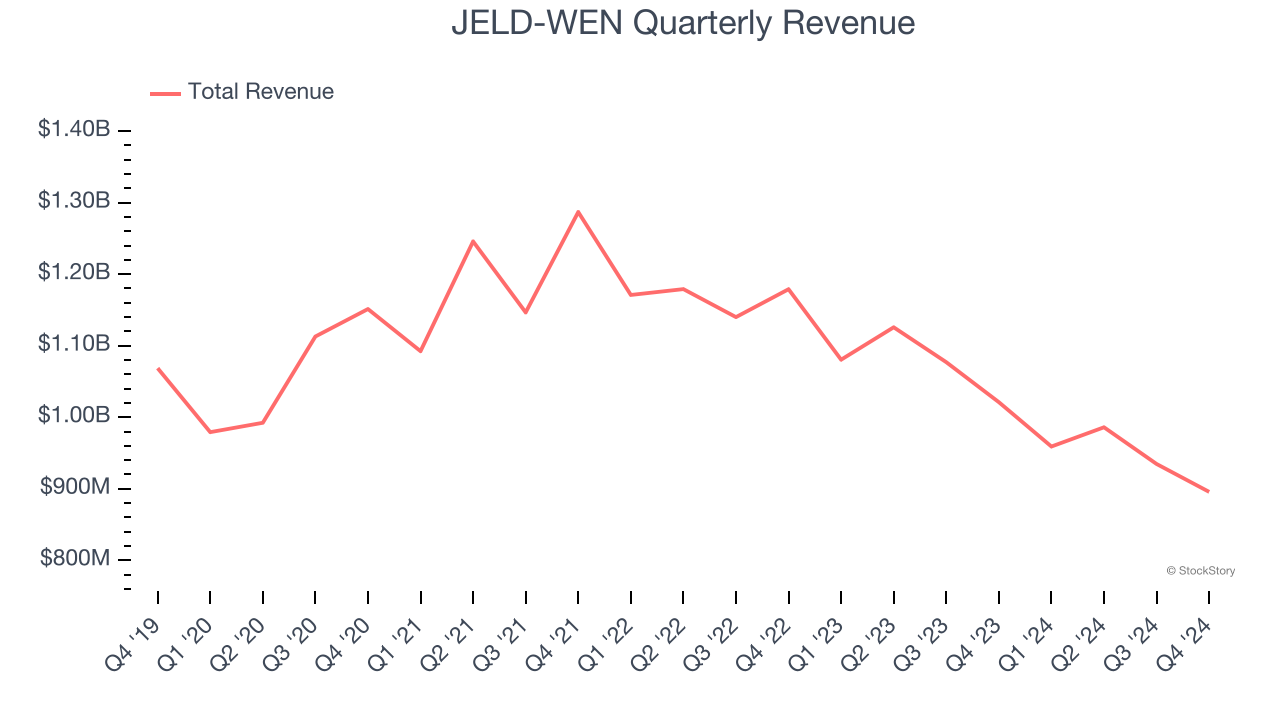
Long-term growth is the most important, but within industrials, a half-decade historical view may miss new industry trends or demand cycles. JELD-WEN’s recent history shows its demand has stayed suppressed as its revenue has declined by 10.1% annually over the last two years. JELD-WEN isn’t alone in its struggles as the Home Construction Materials industry experienced a cyclical downturn, with many similar businesses observing lower sales at this time. 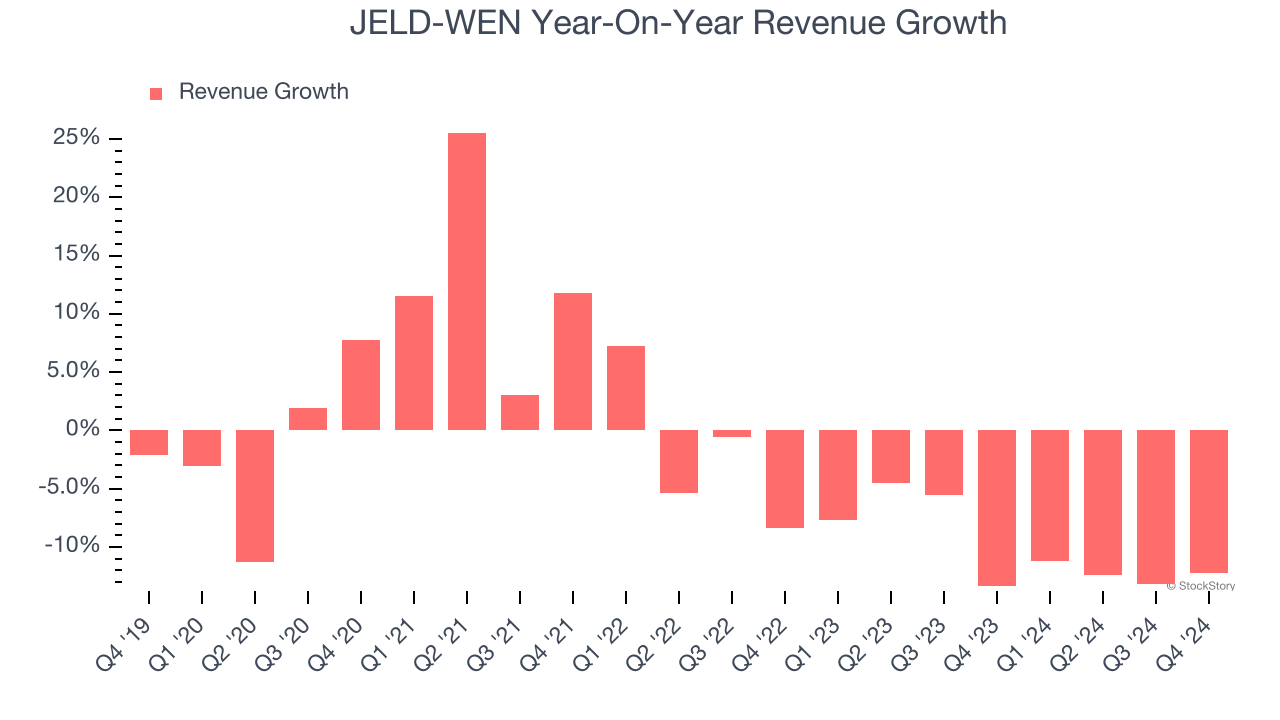
JELD-WEN also reports organic revenue, which strips out one-time events like acquisitions and currency fluctuations that don’t accurately reflect its fundamentals. Over the last two years, JELD-WEN’s organic revenue averaged 9.2% year-on-year declines. Because this number aligns with its normal revenue growth, we can see the company’s core operations (not acquisitions and divestitures) drove most of its results. 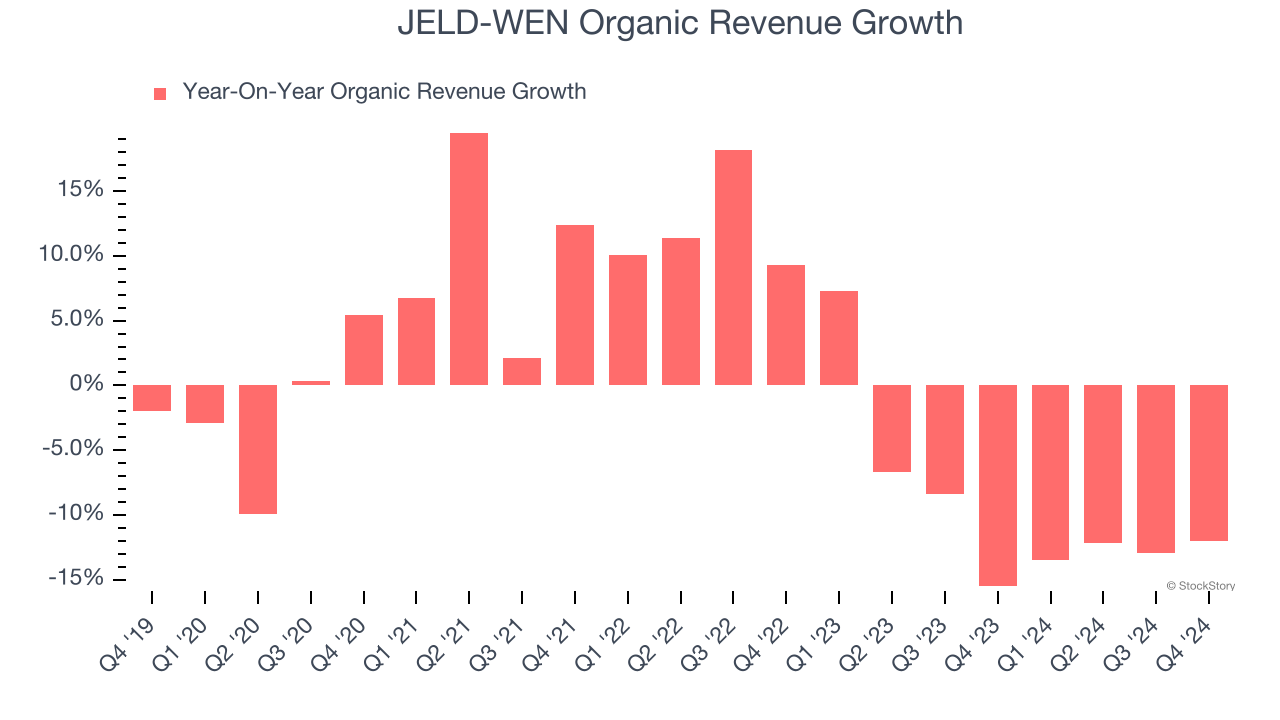
This quarter, JELD-WEN’s revenue fell by 12.3% year on year to $895.7 million but beat Wall Street’s estimates by 5.8%.
Looking ahead, sell-side analysts expect revenue to decline by 7.3% over the next 12 months. While this projection is better than its two-year trend, it's tough to feel optimistic about a company facing demand difficulties.
Here at StockStory, we certainly understand the potential of thematic investing. Diverse winners from Microsoft (MSFT) to Alphabet (GOOG), Coca-Cola (KO) to Monster Beverage (MNST) could all have been identified as promising growth stories with a megatrend driving the growth. So, in that spirit, we’ve identified a relatively under-the-radar profitable growth stock benefiting from the rise of AI, available to you FREE via this link.
Operating Margin
JELD-WEN was profitable over the last five years but held back by its large cost base. Its average operating margin of 2.5% was weak for an industrials business. This result isn’t too surprising given its low gross margin as a starting point.
Analyzing the trend in its profitability, JELD-WEN’s operating margin decreased by 7.8 percentage points over the last five years. The company’s performance was poor no matter how you look at it - it shows operating expenses were rising and it couldn’t pass those costs onto its customers.
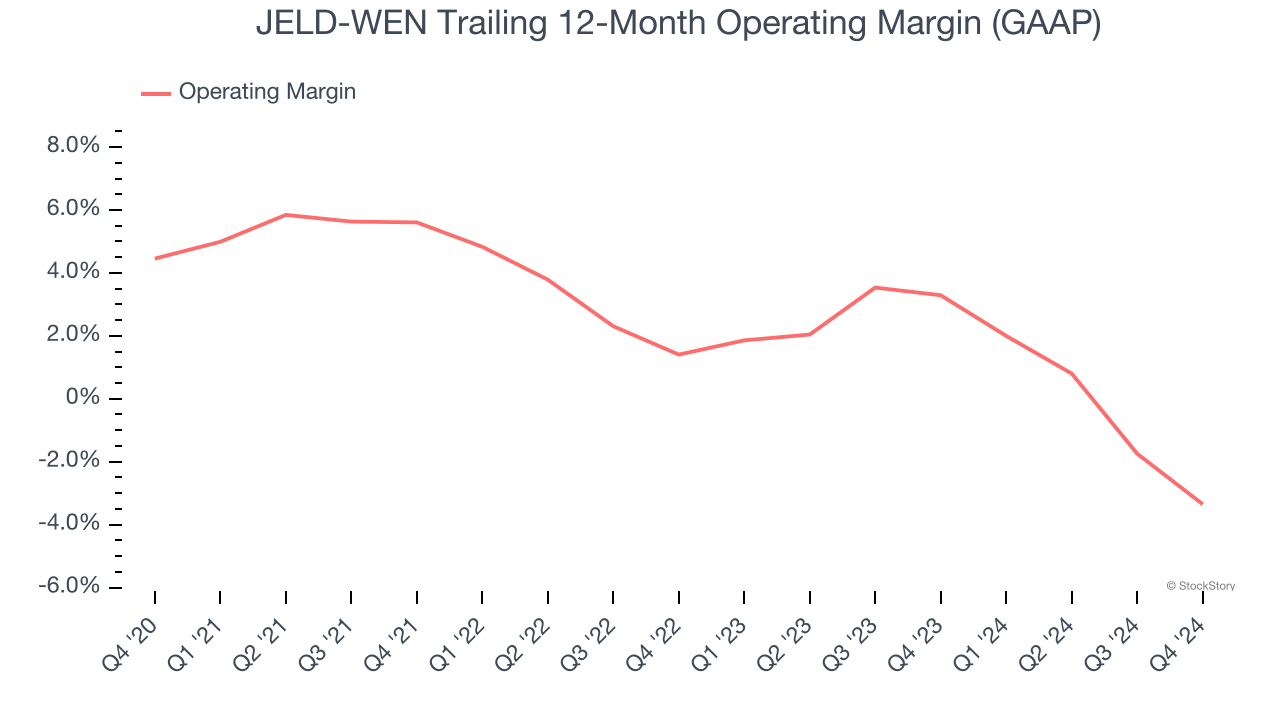
In Q4, JELD-WEN generated an operating profit margin of negative 5.7%, down 6.4 percentage points year on year. Since JELD-WEN’s operating margin decreased more than its gross margin, we can assume it was recently less efficient because expenses such as marketing, R&D, and administrative overhead increased.
Earnings Per Share
Revenue trends explain a company’s historical growth, but the long-term change in earnings per share (EPS) points to the profitability of that growth – for example, a company could inflate its sales through excessive spending on advertising and promotions.
Sadly for JELD-WEN, its EPS declined by more than its revenue over the last five years, dropping 7.8% annually. This tells us the company struggled because its fixed cost base made it difficult to adjust to shrinking demand.
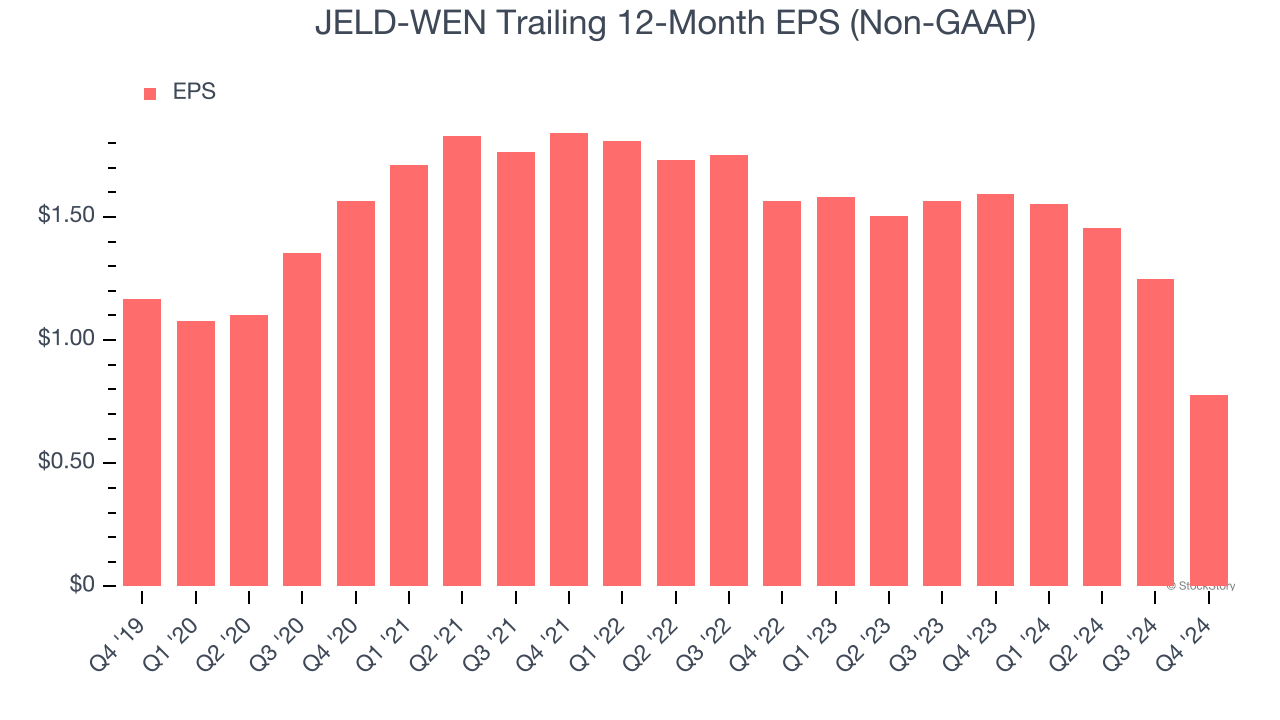
Diving into the nuances of JELD-WEN’s earnings can give us a better understanding of its performance. As we mentioned earlier, JELD-WEN’s operating margin declined by 7.8 percentage points over the last five years. This was the most relevant factor (aside from the revenue impact) behind its lower earnings; taxes and interest expenses can also affect EPS but don’t tell us as much about a company’s fundamentals.
Like with revenue, we analyze EPS over a more recent period because it can provide insight into an emerging theme or development for the business.
For JELD-WEN, its two-year annual EPS declines of 29.5% show it’s continued to underperform. These results were bad no matter how you slice the data.
In Q4, JELD-WEN reported EPS at negative $0.10, down from $0.37 in the same quarter last year. This print missed analysts’ estimates. Over the next 12 months, Wall Street expects JELD-WEN’s full-year EPS of $0.78 to shrink by 3.1%.
Key Takeaways from JELD-WEN’s Q4 Results
We were impressed by how significantly JELD-WEN blew past analysts’ organic revenue and EBITDA expectations this quarter. On the other hand, its full-year revenue and EBITDA guidance fell short of Wall Street’s estimates. Overall, this was a softer quarter due to the outlook, but the stock traded up 1.1% to $8.89 immediately after reporting.
Is JELD-WEN an attractive investment opportunity right now? The latest quarter does matter, but not nearly as much as longer-term fundamentals and valuation, when deciding if the stock is a buy. We cover that in our actionable full research report which you can read here, it’s free.





